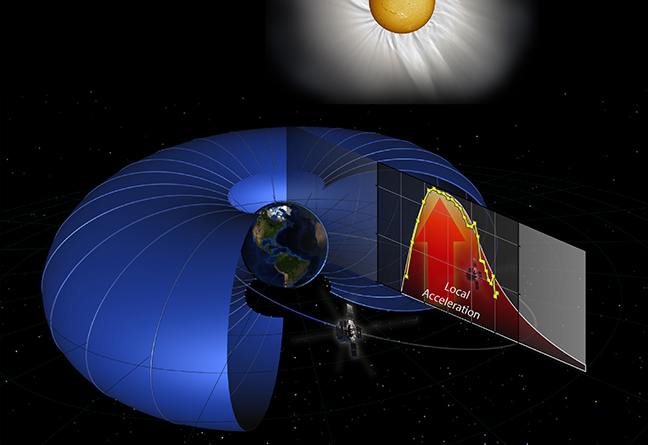July 25, 2013
Media Contact:
Geoff Brown
(240) 228-5618
Geoffrey.Brown@jhuapl.edu
Steve Cole
NASA Headquarters, Washington, D.C.
(202) 358-0918
stephen.e.cole@nasa.gov
Susan Hendrix
Goddard Space Flight Center, Greenbelt, Md.
(301) 286-7745
susan.m.hendrix@nasa.gov
Van Allen Probes Discover Particle Accelerator in Heart of Van Allen radiation belts
Scientists have discovered a massive particle accelerator in the heart of one of the harshest regions of near-Earth space, a region of super-energetic, charged particles surrounding the globe called the Van Allen radiation belts.
New results from NASA’s Van Allen Probes show that the acceleration energy is in the belts themselves: particles inside the belts are sped up by a local kicks of energy, buffeting the particles to ever faster speeds, each kick acting as a perfectly timed push on a moving swing.
Knowing the location of the acceleration will help scientists improve space weather predictions, since changes in the radiation belts can be risky for satellites near Earth. The results were published in Science magazine on July 25, 2013.
The discovery that the particles are accelerated by a local energy source is akin to the discovery that hurricanes grow from a local energy source, such as a region of warm ocean water. In the case of the radiation belts, the source is a region of intense electromagnetic waves.

Recent observations by NASA's twin Van Allen Probes show that particles in the radiation belts surrounding Earth are accelerated by a local kick of energy, helping to explain how these particles reach speeds of 99 percent the speed of light. Image Credit: G. Reeves/M. Henderson
"Until the 1990s, we thought that the Van Allen belts were pretty well-behaved and changed slowly,"
says Geoff Reeves, the first author on the paper and a radiation belt scientist at Los Alamos National Laboratory in Los Alamos, N.M. "With more and more measurements, however, we realized how quickly and unpredictably the radiation belts changed. They are basically never in equilibrium, but in a constant state of change."
In order for scientists to understand such changes better, the twin Van Allen Probes fly straight through this intense area of space. When the mission launched in August 2012, it had as one of its top-level goals to understand how particles in the belts are accelerated to ultra-high energies. With two spacecraft taking simultaneous measurements with advanced technology instruments, the Van Allen Probes was able to distinguish between two broad possibilities on what speeds up the particles to such amazing speeds: radial acceleration or local acceleration.
In radial acceleration, particles are transported perpendicular to the magnetic fields that surround the Earth, from areas of low magnetic strength far from Earth to areas of high magnetic strength nearer Earth. The laws of physics dictate that the particle speeds in this scenario will increase as the magnetic field strength increases. So the speed would increase as the particles move toward the Earth, much the way a rock rolling down a hill gathers speed simply due to gravity. The local acceleration theory posits that the particles gain energy from a local energy source more similar to the way a hot ocean water spawns a hurricane above it.
Reeves and his team found they could distinguish between these two theories when they observed a rapid energy increase in the radiation belts on Oct. 9, 2012. The observations did not show an intensification in energy starting at high altitude and moving gradually toward Earth.
Instead they showed an increase in energy that started right in the middle of the radiation belts and gradually spread both inward and outward, implying a local acceleration source. The research shows that the local energy comes from electromagnetic waves coursing through the belts, tapping energy from other particles residing in the same region of space
“These new results go a long way toward answering the questions of where and how particles are accelerated to high energy,” says Mona Kessel, Van Allen Probes Program Scientist at NASA Headquarters. “One mission goal has been substantially addressed.”
The challenge for scientists now is to determine which waves are at work. Such a task will also be helped along by the Van Allen Probes, which were also carefully designed to measure and distinguish between the numerous types of electromagnetic waves.
“One of the most exciting aspects of this mission is taking advantage of the giant particle accelerator above our planet,” says Barry Mauk, Van Allen Probes Project Scientist at the Johns Hopkins University Applied Physics Laboratory (APL). “We now have a way to make investigations into fundamental properties of the universe that just weren’t possible before the launch of the technologies on the probes.”
APL built and operates the twin Van Allen Probes for NASA. The Van Allen Probes comprise the second mission in NASA's Living With a Star program, managed by Goddard, to explore aspects of the connected sun-Earth system that directly affect life and society.
The Van Allen Probes are part of NASA's Living With a Star Program to explore aspects of the connected sun-Earth system that directly affect life and society. LWS is managed by the agency's Goddard Space Flight Center in Greenbelt, Md. APL built the twin spacecraft and manages the mission for NASA.

